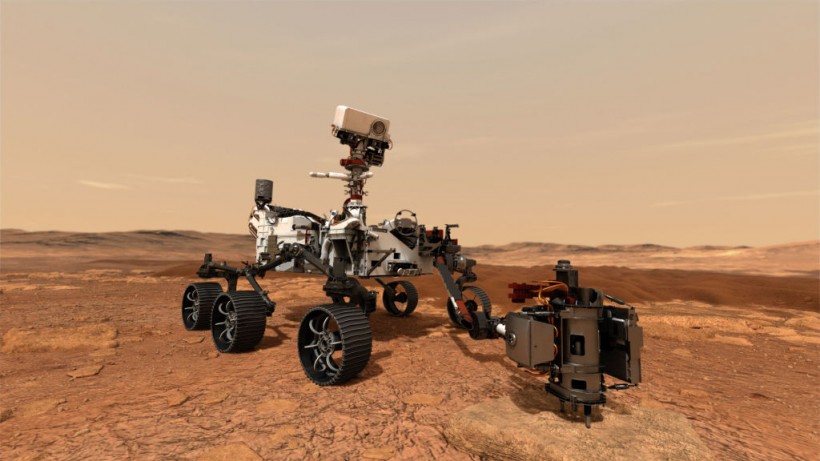Mars is the nearest planet most of us know that astronomers, especially the National Aeronautics and Space Administration (NASA), are curious about. The MARS Perseverance Rover plays an important role in NASA's mission of tacking signs of ancient life and collecting samples of rock and regolith for a possible return to Earth.
Here are the 10 big facts you need to know about the MARS Perseverance Rover.
1. The Mission
The mission's name is Mars 2020, with the rover named, Perseverance. According to NASA, it helps to seek signs of ancient life and gather samples of rock and regolith (broken rock and soil) for a possible return to Earth. The mission was launched on July 30, 2020, and landed on the Jezero Crater on Mars on February 18, 2021.
2. Vital Statistics
The car-size Perseverance rover looks similar to its predecessor, Curiosity, according to NASA. However, it also represents quite a few technological advances since Curiosity was designed.
Here are the numbers:
Length: 10 feet (3 meters).
Weight: 2,260 pounds (1,025 kilograms).
Wheels: Six aluminum wheels with titanium spokes.
Top speed: Just under one tenth of a mile per hour (152 meters per hour).
3. On a Mission
Perseverance is performing much more than just capturing amazing images of Mars. The rover is a laboratory on wheels. These are some of the key mission objectives:
- Look for signs of ancient microbial life.
- Collect Martian rock and dust samples for later return to Earth.
- Deliver an experimental helicopter.
- Study the climate and geology of Mars.
- Demonstrate technology for future Mars missions.
The mission is planned to last for at least one Mars year, which works out to about 687 days on Earth (it takes longer for Mars to go around the sun).
4. Science Instruments
Perseverance is filled with seven instruments chosen to help it achieve its mission objectives. You can get the full rundown from NASA, but here are some highlights:
- Mastcam-Z: The camera system mounted on the rover's mast is equivalent to eyes on a head.
- Moxie: The Mars Oxygen In-Situ Resource Utilization Experiment is one of the ways Perseverance is helping to prepare humans to go to Mars. This instrument is designed to make oxygen from the carbon dioxide atmosphere.
- SuperCam: When you put a camera, laser and spectrometers together, you get SuperCam, an instrument that looks for organic compounds, a key part of the quest for signs of past microbial life.
- Sherloc: The Scanning Habitable Environments with Raman & Luminescence for Organics & Chemicals tool, or Sherloc, as the instrument is affectionately known, will search for signs of life on the red planet.
Read Also: NASA Mars Rover Pictures and Videos: Perseverance Spots Mars Moon Deimos in Cool Clip

5. Sampling
The rover will be gathering more samples as it moves about in the crater. In a report by Amanda Kooser, Perseverance went on to collect a second sample from Rochette. An initial study of the rock has already pointed to a better understanding of the history of the Jezero Crater. It likely held water for long periods of time in its past. "It looks like our first rocks reveal a potentially habitable sustained environment," said Perseverance project scientist Ken Farley. That's good news in the search for signs of microbes.
6. 'Perseverance Is The First Leg Of a Round Trip to Mars'
Verifying ancient microscopic life on Mars carries an enormous burden of proof. Perseverance is the first rover to bring a sample-gathering system to Mars that will package promising examples of rocks and sediments for return to Earth by a future mission.
A Mars Sample Return campaign is being planned by NASA and the European Space Agency because here on Earth we can investigate the samples with instruments too large and complex to send to Mars. Terrestrial laboratories would be used to establish whether any potential signs of life detected by the rover are definitive evidence of past life.
7. 'Explore as one'
Perseverance is distant from Earth, but it carries remembrances of its home planet. More than 10.9 million people signed up to have their names travel with the rover through NASA's Send Your Name to Mars public outreach program. The names are etched on small silicon chips that NASA installed on the rover on an aluminum plate underneath a protective shield.
8. Perseverance Will Also Be Collecting Important Data About Mars' Geology And Climate.
Mars orbiters have been collecting images and other data from Jezero Crater from about 200 miles (322 kilometers) above, but finding signs of ancient life on the surface will require much closer inspection. It demands a rover like Perseverance, which can look for signs that may be related to life and can analyze the context in which they were found to see if they were biological in origin.
Understanding Mars' past climate conditions and reading the geological history embedded in its rocks will also give us a sense of why Earth and Mars - which formed from the same primordial stuff - ended up so different.
9. Jezero Crater
It is located just north of Mars' equator and was once home to a river delta. That history of water makes it a prime spot to look for signs of past microbial life. "The landing site in Jezero Crater offers geologically rich terrain, with landforms reaching as far back as 3.6 billion years old, that could potentially answer important questions in planetary evolution and astrobiology," NASA's Thomas Zurbuchen said when the site was announced in 2018.
10. Zooming Into The Jezero Delta
NASA selected Jezero Crater as Perseverance's landing site specifically because it gives the rover access to a large stack of rocks that sits at the end of a dry river valley. Based on satellite images, scientists think that these rocks are made of sediment deposited by an ancient river that flowed into a lake roughly 3.5 billion years ago. If true, this location could have been an excellent environment for life.
However, the resolution of the satellite data isn't high enough to say for sure whether the sediments were deposited slowly into a long-lived lake or whether the structure formed under drier conditions. The only way to know with certainty was to take images from the surface of Mars.
This is just a step towards discovering more about the Red Planet - Mars. Little by little, humans will be able to study and learn more about it and the results could be both shocking and amazing in the near future.
Related Article: NASA Perseverance Rover Captures Photo of Odd-Looking Rock: 3 Other Unusual Photos Captured by the Mars Rover










